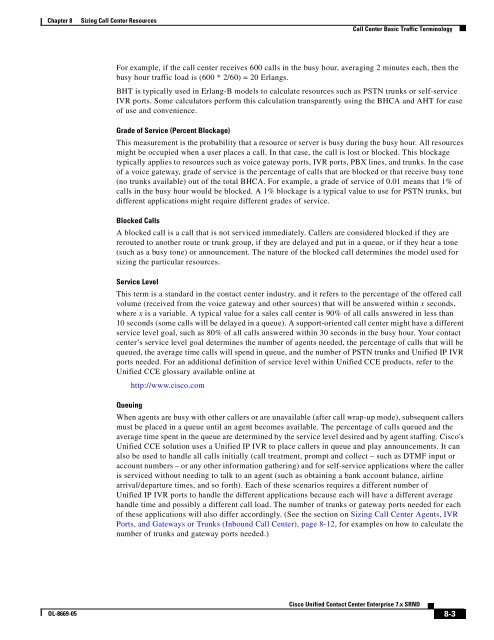Cisco Unified Contact Center Enterprise Solution Reference ...
Cisco Unified Contact Center Enterprise Solution Reference ...
Cisco Unified Contact Center Enterprise Solution Reference ...
Create successful ePaper yourself
Turn your PDF publications into a flip-book with our unique Google optimized e-Paper software.
Chapter 8 Sizing Call <strong>Center</strong> Resources<br />
OL-8669-05<br />
Call <strong>Center</strong> Basic Traffic Terminology<br />
For example, if the call center receives 600 calls in the busy hour, averaging 2 minutes each, then the<br />
busy hour traffic load is (600 * 2/60) = 20 Erlangs.<br />
BHT is typically used in Erlang-B models to calculate resources such as PSTN trunks or self-service<br />
IVR ports. Some calculators perform this calculation transparently using the BHCA and AHT for ease<br />
of use and convenience.<br />
Grade of Service (Percent Blockage)<br />
This measurement is the probability that a resource or server is busy during the busy hour. All resources<br />
might be occupied when a user places a call. In that case, the call is lost or blocked. This blockage<br />
typically applies to resources such as voice gateway ports, IVR ports, PBX lines, and trunks. In the case<br />
of a voice gateway, grade of service is the percentage of calls that are blocked or that receive busy tone<br />
(no trunks available) out of the total BHCA. For example, a grade of service of 0.01 means that 1% of<br />
calls in the busy hour would be blocked. A 1% blockage is a typical value to use for PSTN trunks, but<br />
different applications might require different grades of service.<br />
Blocked Calls<br />
A blocked call is a call that is not serviced immediately. Callers are considered blocked if they are<br />
rerouted to another route or trunk group, if they are delayed and put in a queue, or if they hear a tone<br />
(such as a busy tone) or announcement. The nature of the blocked call determines the model used for<br />
sizing the particular resources.<br />
Service Level<br />
This term is a standard in the contact center industry, and it refers to the percentage of the offered call<br />
volume (received from the voice gateway and other sources) that will be answered within x seconds,<br />
where x is a variable. A typical value for a sales call center is 90% of all calls answered in less than<br />
10 seconds (some calls will be delayed in a queue). A support-oriented call center might have a different<br />
service level goal, such as 80% of all calls answered within 30 seconds in the busy hour. Your contact<br />
center’s service level goal determines the number of agents needed, the percentage of calls that will be<br />
queued, the average time calls will spend in queue, and the number of PSTN trunks and <strong>Unified</strong> IP IVR<br />
ports needed. For an additional definition of service level within <strong>Unified</strong> CCE products, refer to the<br />
<strong>Unified</strong> CCE glossary available online at<br />
http://www.cisco.com<br />
Queuing<br />
When agents are busy with other callers or are unavailable (after call wrap-up mode), subsequent callers<br />
must be placed in a queue until an agent becomes available. The percentage of calls queued and the<br />
average time spent in the queue are determined by the service level desired and by agent staffing. <strong>Cisco</strong>'s<br />
<strong>Unified</strong> CCE solution uses a <strong>Unified</strong> IP IVR to place callers in queue and play announcements. It can<br />
also be used to handle all calls initially (call treatment, prompt and collect – such as DTMF input or<br />
account numbers – or any other information gathering) and for self-service applications where the caller<br />
is serviced without needing to talk to an agent (such as obtaining a bank account balance, airline<br />
arrival/departure times, and so forth). Each of these scenarios requires a different number of<br />
<strong>Unified</strong> IP IVR ports to handle the different applications because each will have a different average<br />
handle time and possibly a different call load. The number of trunks or gateway ports needed for each<br />
of these applications will also differ accordingly. (See the section on Sizing Call <strong>Center</strong> Agents, IVR<br />
Ports, and Gateways or Trunks (Inbound Call <strong>Center</strong>), page 8-12, for examples on how to calculate the<br />
number of trunks and gateway ports needed.)<br />
<strong>Cisco</strong> <strong>Unified</strong> <strong>Contact</strong> <strong>Center</strong> <strong>Enterprise</strong> 7.x SRND<br />
8-3
















